
Labor Force Participation Continues to Reach Highest Levels in a Decade
According to preliminary seasonally adjusted figures released today by the New York State Department of Labor, the number of private sector jobs in New York State increased over the month by 7,500, or 0.1%, to 8,261,800 in September 2023. The number of private sector jobs in the U.S. increased by 0.2% in September 2023.
New York State's private sector jobs (not seasonally adjusted) increased by 119,400, or 1.5%, over the year in September 2023, which was less than the 1.9% increase in the number of private sector jobs in the U.S.
New York State's seasonally adjusted unemployment rate increased from 3.9% in August to 4.0% in September 2023. At the same time, New York State's labor force (seasonally adjusted) increased by 4,100. As a result, the statewide labor force participation rate increased from 61.5% to 61.6% in September 2023, matching its highest level in a decade.
The number of private sector jobs in New York State is based on a payroll survey of New York businesses conducted by the U.S. Department of Labor’s Bureau of Labor Statistics (BLS). Monthly payroll employment estimates are preliminary and subject to revision as more complete data become available the following month. The BLS calculates New York State’s unemployment rate based partly upon the results of the monthly Current Population Survey (CPS) of approximately 3,100 households in the State.
Note: Seasonally adjusted data provide the most valid month-to-month comparison. Non-seasonally adjusted data are valuable in year-to-year comparisons of the same month – for example, September 2022 versus September 2023.
Statewide Industry Employment
September 2023 – Seasonally Adjusted
- On a net basis, the total number of nonfarm jobs in the state increased by 21,700 over the month, while private sector jobs increased by 7,500 in September 2023.
- At the same time, the total number of nonfarm jobs in the nation increased by 336,000, while private sector jobs increased by 263,000.
NYS Matches the Nation in Nonfarm Job Growth
Over-the-Month % Change in Total Nonfarm & Private Sector Jobs, August – September 2023
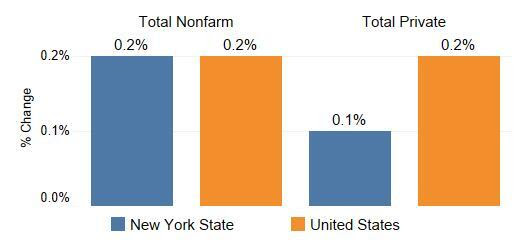
Total Nonfarm and Private Sector Jobs Increased in September 2023Total Nonfarm and Private Sector Jobs (in 1000s), January 1990 – September 2023 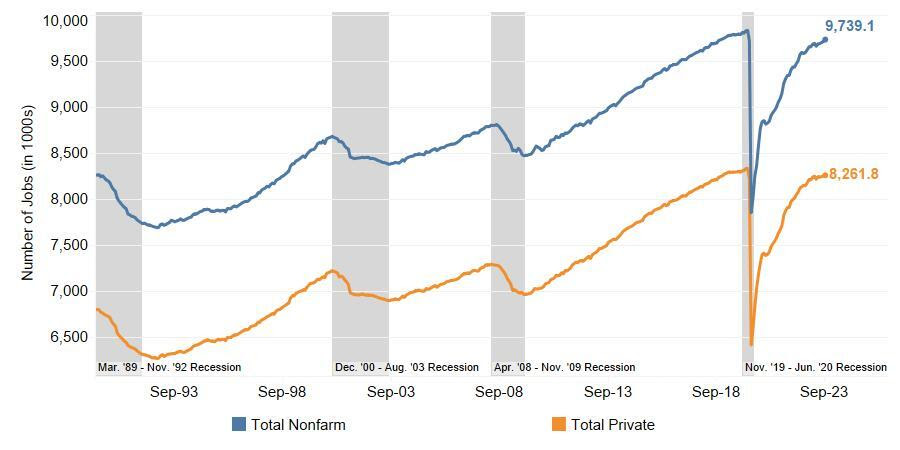
Statewide UnemploymentSeptember 2023 – Seasonally Adjusted The statewide unemployment increased from 3.9% in August to 4.0% in September 2023. New York City’s unemployment rate held constant at 5.3%. Outside of New York City, the unemployment rate increased from 3.0% in August to 3.1% in September 2023. The number of unemployed New Yorkers increased over the month by 7,900, from 384,700 in August to 392,600 in September 2023.
NYS Unemployment Rate Increased Over the MonthLabor Force Statistics, September 2022, August – September 2023 
The Labor Force and Number of Unemployed Increased in SeptemberTotal Labor Force & Number of Unemployed, January 2009 – September 2023 
Unemployment Rate Increased in NYS, Held Constant in USUnemployment Rate, NYS & US, January 2009 – September 2023 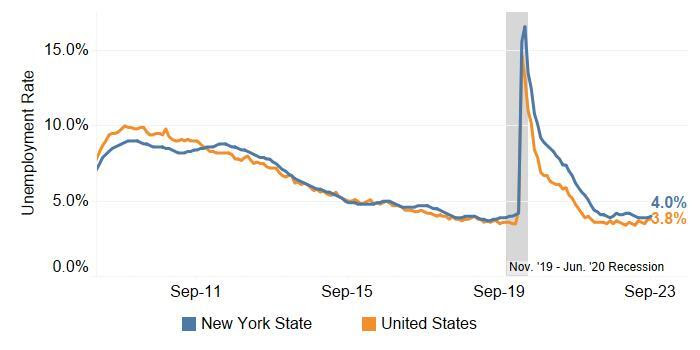 Unemployment Rate Held Constant in NYC and Increased in Balance of StateUnemployment Rate, NYC & BOS, January 2009 – September 2023 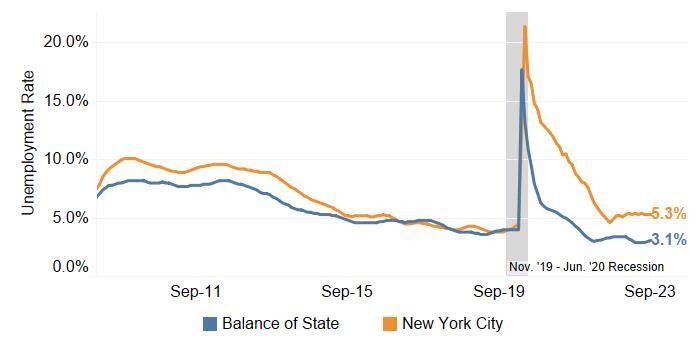
Private Education & Health Services Jobs Increased by 5.7% Over the YearOver-the-Year Change in Jobs by Major Industry Sector, September 2022 – September 2023 
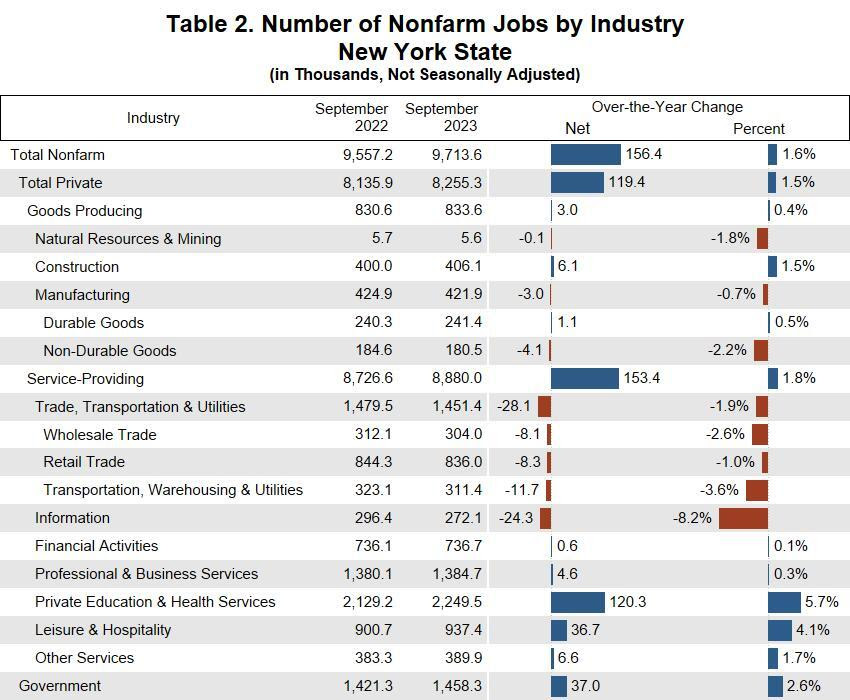 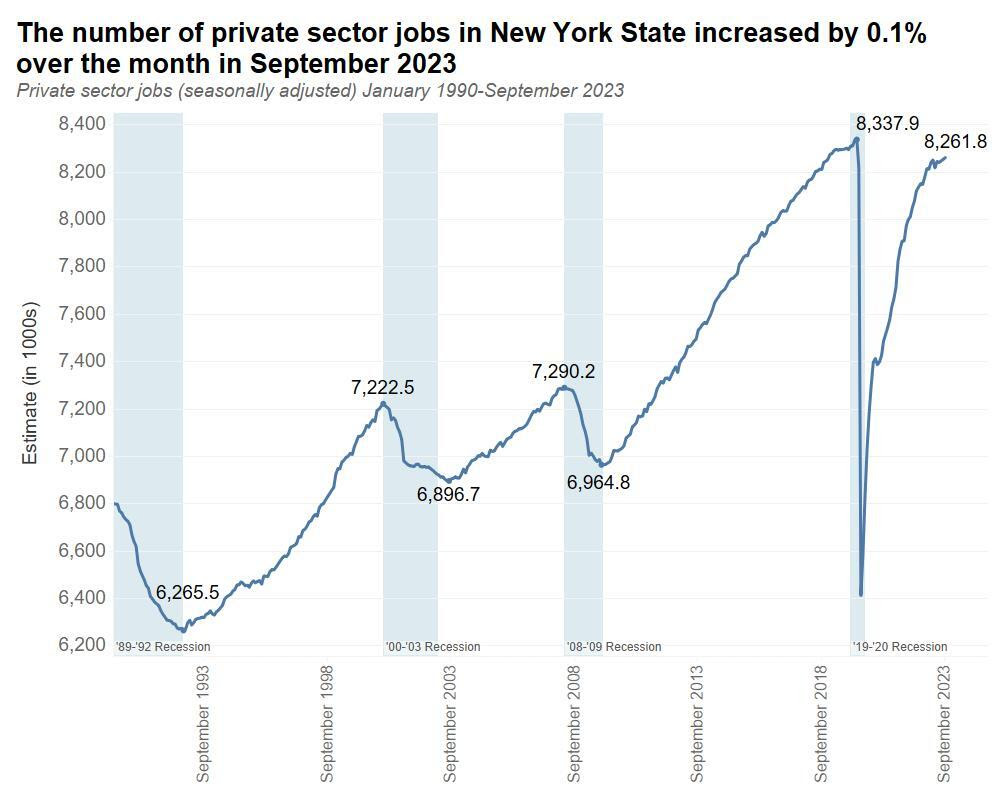
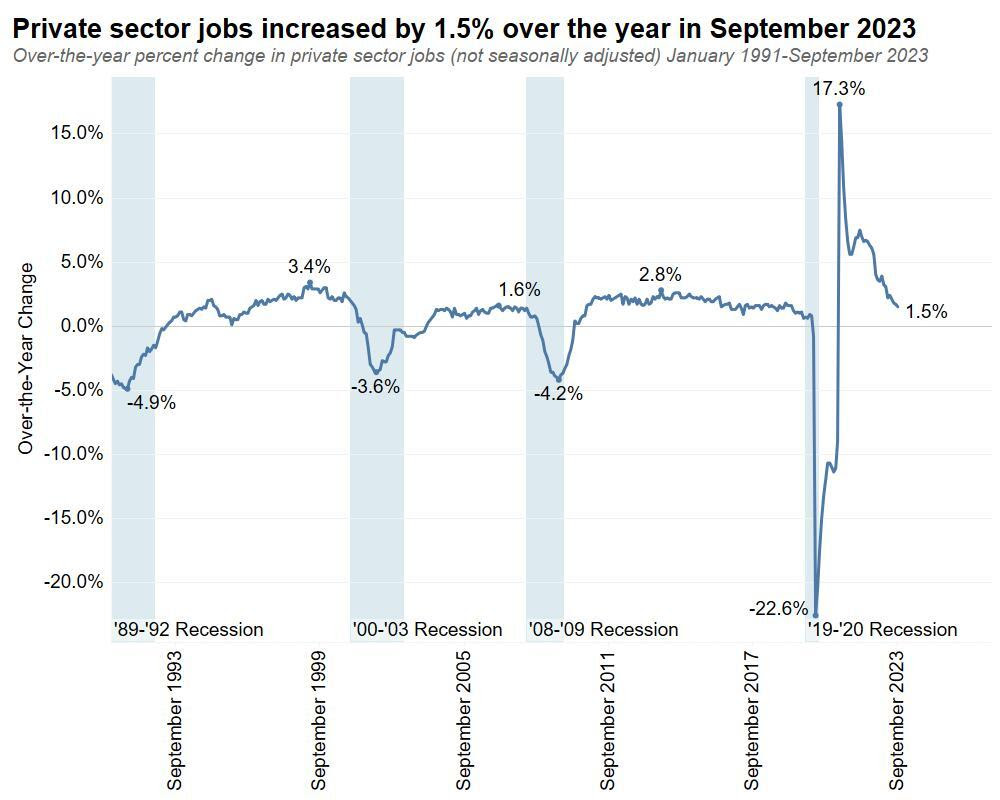  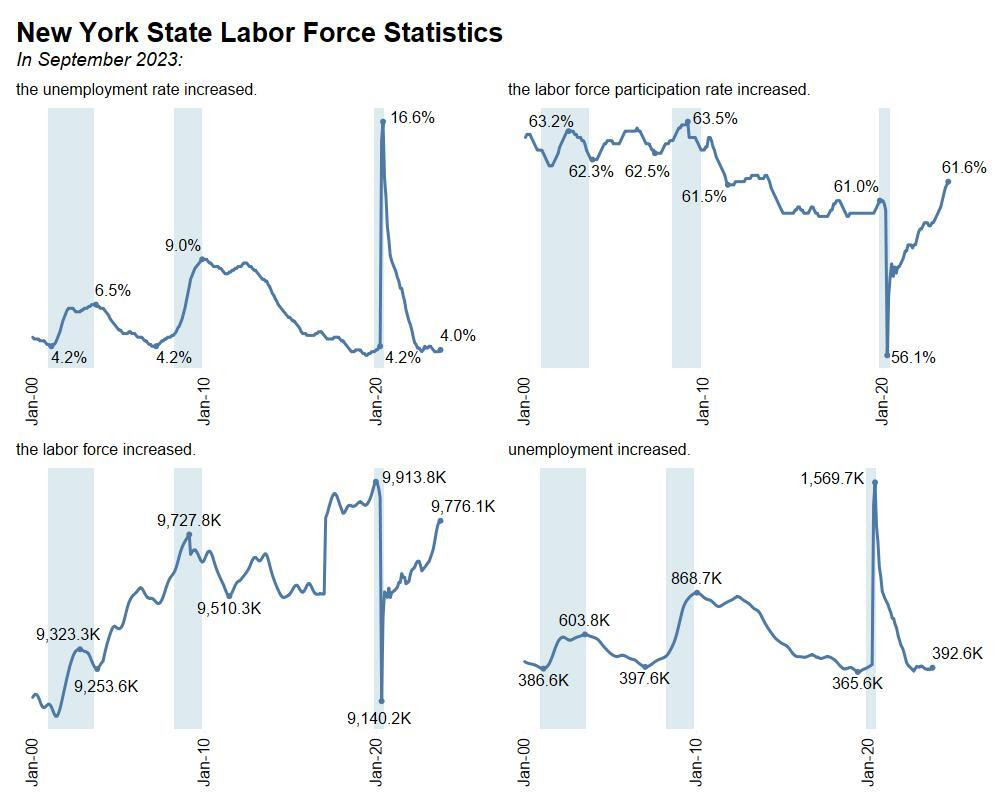
Jobs and Unemployment Fact Sheet This fact sheet conveys important technical information that will contribute to a better understanding of labor force data (“household survey”), including resident employment/unemployment rates, and jobs by industry data (“business survey”), which are presented in the New York State Department of Labor’s monthly press release. State Unemployment Rates Based on Regression Model Beginning with data for January 1996, unemployment rates for New York State and all other states (as well as New York City and the City of Los Angeles) have been estimated using time-series regression statistical models developed by the U.S. Bureau of Labor Statistics (BLS). Advantage of Regression Model Use of a time-series regression model reduces the month-to-month variation in unemployment rates and resident employment by reducing variation caused by sampling errors and other components of statistical noise (irregularities). Benchmarking of Estimates Once each year, labor force estimates, such as civilian labor force and the unemployment rate, are revised to reflect updated input data including new Census Bureau populations controls, newly revised establishment jobs data and new state-level annual average data from the Current Population Survey (CPS). As part of this procedure, all state figures are reviewed, revised as necessary and then re-estimated. This process is commonly referred to as “benchmarking.” Changes in Methodology Labor force estimates are now produced with an improved time-series regression model, which utilizes “real-time” benchmarking. “Real-time” benchmarking reduces end-of-year revisions, which also means that major economic events will be reflected in a more timely manner in state labor force estimates. In addition, the new methodology includes an updated way of estimating for sub-state areas (e.g. counties, metro areas) the number of unemployed who are new entrants or re-entrants into the labor force. This change in methodology will result in lower unemployment rates in some areas and increased rates in others. Unemployed and UI Beneficiaries The estimate of the number of unemployed includes all persons who had no employment during the reference week (the week including the 12th of the month), were available for work, except for temporary illness, and had made specific efforts to find employment sometime during the 4-week period ending with the reference week. Unemployment insurance (UI) beneficiaries include those who apply for and qualify for UI benefits. Consequently, the estimate of the number of unemployed and the number of UI beneficiaries do not necessarily move in tandem. Jobs Data Jobs data are obtained from a separate joint federal-state survey of business establishments. The survey, called the Current Employment Statistics of Establishments, has a sample size of 18,000 establishments in New York State. It excludes self-employed workers, agricultural workers, unpaid family workers and domestic workers employed by private households. This data represents a count of jobs by place of work. Data for each month is revised the following month as more complete information becomes available. The New York State Department of Labor is an Equal Opportunity Employer/Program. |
|
|
|
|







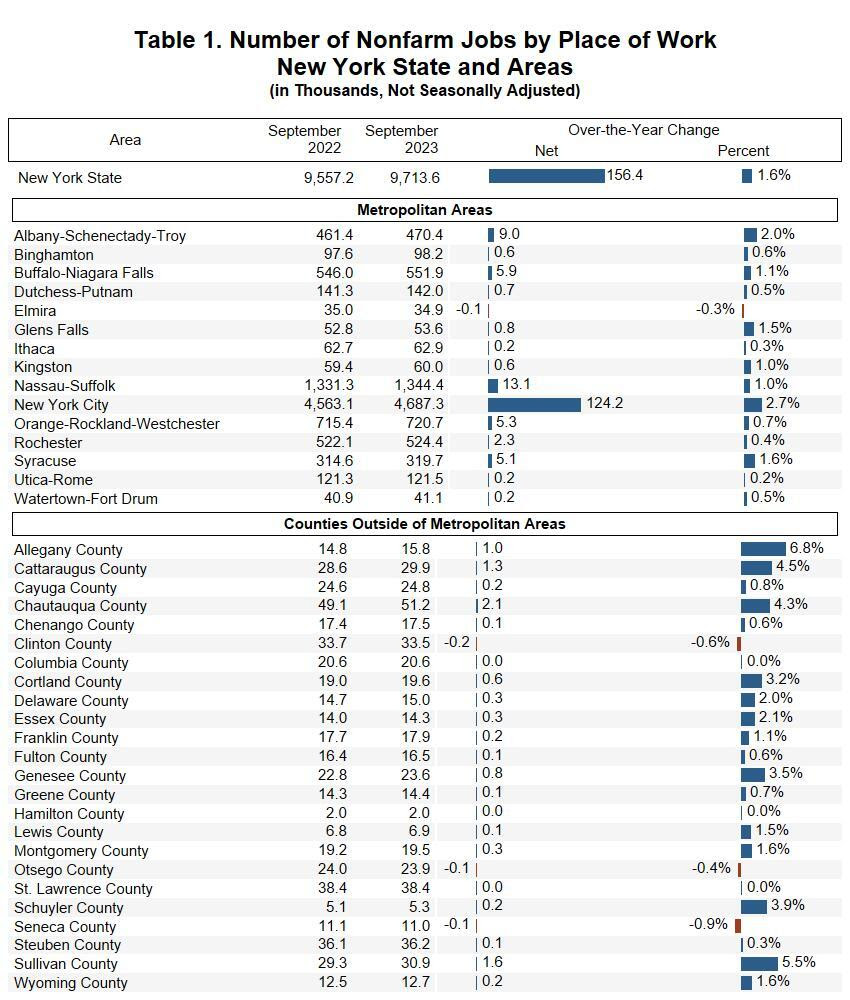





No comments:
Post a Comment